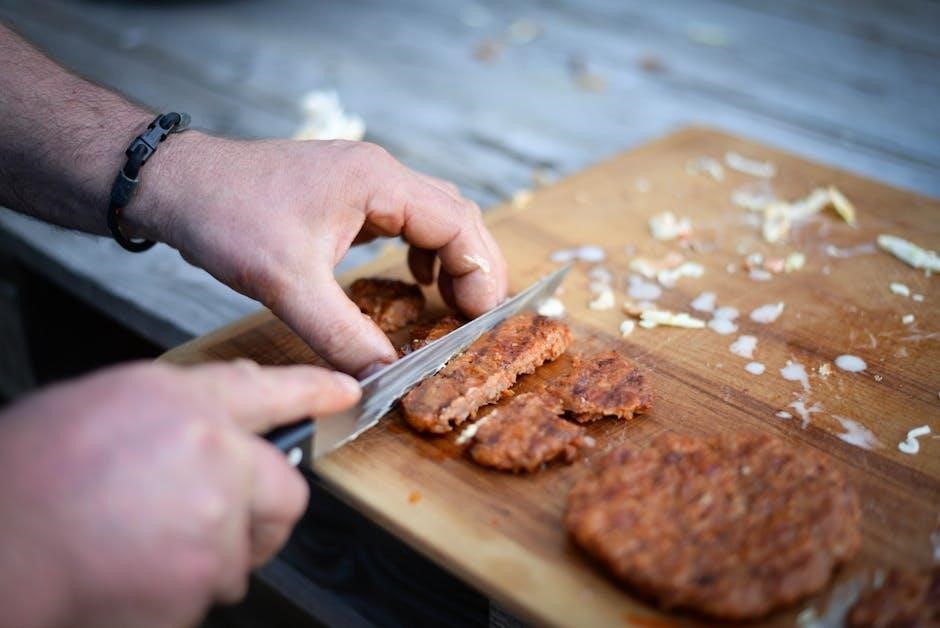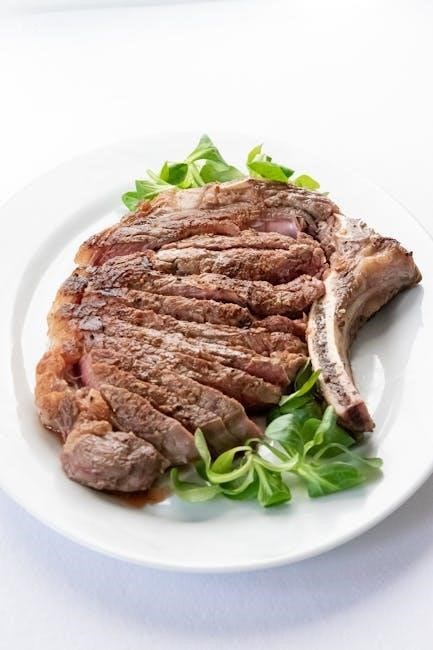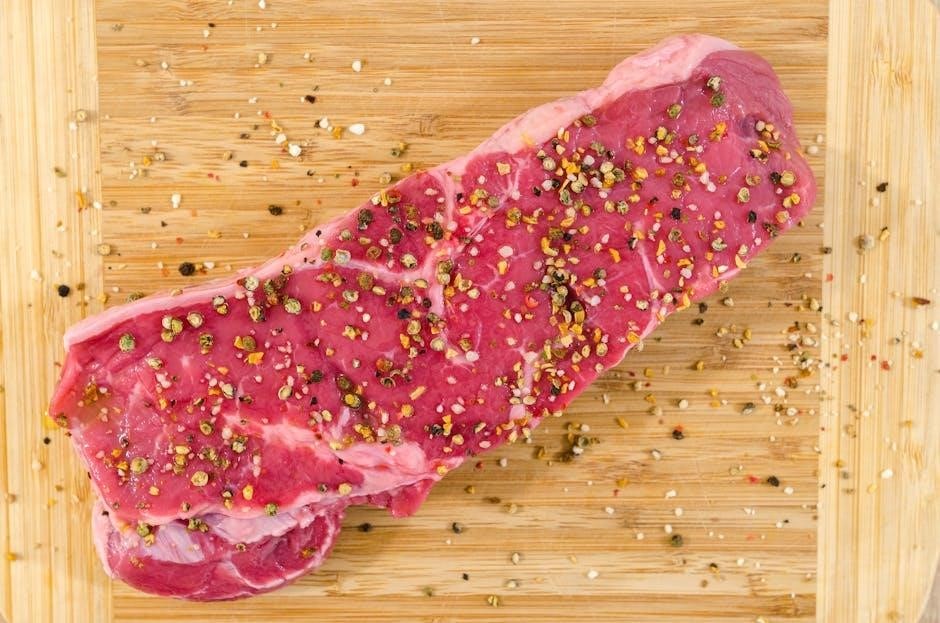Navigating the world of beef cuts can be simplified with the right instructions. Diagrams and charts are helpful resources for butchers and home cooks alike. These visuals detail primal and sub-primal cuts, aiding in understanding where each cut originates and its ideal use.
Understanding Beef Primal Cuts
Beef primal cuts are the initial divisions of the carcass during butchering, each with distinct characteristics. These large sections, including the chuck, rib, loin, round, brisket, flank, plate and shank, possess varying degrees of tenderness and fat content. The chuck, located in the shoulder, is suitable for slow cooking. The rib section yields prized cuts like ribeye. The loin provides tender steaks such as T-bone and sirloin. The round, from the rear leg, requires specific preparation techniques. Understanding these primal cuts is essential for selecting the right cut for your culinary needs and cooking preferences, influencing the final flavor and texture of your meal.
The Beef Cuts Chart
A beef cuts chart serves as a comprehensive visual guide to the various cuts of beef and their origins. It typically illustrates the primal cuts, such as chuck, rib, loin, and round, along with their sub-primal cuts. Charts often include recommended cooking methods, such as grilling, roasting, or braising, tailored to each cut’s characteristics. These charts aid butchers, chefs, and home cooks in identifying and selecting the appropriate cuts for specific culinary applications. Some charts also indicate the tenderness and fat content of each cut, further assisting in making informed decisions. Printable versions are readily available, providing a handy reference tool in the kitchen or at the butcher shop.

Essential Tools for Beef Cutting
Proper tools are crucial for efficient and safe beef cutting. A butcher knife, boning knife, and cleaver are essential for various tasks. Safety equipment, including gloves and an apron, should always be used to prevent injuries and maintain hygiene.
Knives: Butcher Knife, Boning Knife, Cleaver
A butcher knife is a versatile tool for general cutting and trimming of larger beef portions; Its sturdy blade is designed for slicing through meat with ease. A boning knife, with its narrow and flexible blade, is essential for separating meat from bones, ensuring minimal waste. The cleaver, a heavy, broad-bladed knife, is used for chopping through bones and thick sections of meat. Selecting high-quality knives and maintaining their sharpness are key to efficient and safe beef processing, allowing for precise cuts and reduced effort. Always prioritize safety when handling these sharp instruments.
Safety Equipment: Gloves, Apron
When engaging in beef cutting, safety is paramount, and appropriate equipment is crucial. Cut-resistant gloves are essential to protect your hands from accidental cuts and lacerations while handling sharp knives. An apron serves as a barrier, shielding your clothing from meat juices and potential contaminants, maintaining hygiene throughout the cutting process. Furthermore, wearing appropriate footwear can prevent slips and falls in a potentially wet or greasy environment. Prioritizing these safety measures minimizes the risk of injury and ensures a clean and sanitary workspace, making the beef cutting process safer and more efficient.
Cutting the Chuck
The chuck primal cut, sourced from the shoulder, requires specific techniques for optimal yield. Breaking down the chuck involves separating muscles, which will allow for various uses, including roasts, steaks, or ground beef, and even the preparation of chuck tender.
Breaking Down the Chuck Roll
The chuck roll, a subprimal cut from the chuck, is a versatile piece of beef ideal for diverse culinary applications. Breaking it down requires careful separation of its constituent muscles. This process allows for creating various cuts like chuck eye steaks or roasts, depending on the desired tenderness and cooking method.
Properly separating the muscles within the chuck roll can yield more tender and manageable portions, enhancing the overall eating experience. Understanding the muscle structure will improve the final product, whether grilled, braised, or slow-cooked. Attention to detail ensures maximum value from the entire chuck roll.
Preparing Chuck Tender
The chuck tender, also known as mock tender, is a flavorful but often overlooked cut from the shoulder. Preparing it involves removing any silverskin or tough connective tissue. This enhances tenderness and ensures a more pleasant eating experience. Marinating the chuck tender before cooking can further improve its texture and flavor profile.
Due to its location, it can be less tender than other cuts. Slow cooking methods like braising are well-suited for chuck tender, breaking down the remaining connective tissue. Slicing against the grain after cooking will also maximize tenderness. Proper preparation transforms this affordable cut into a delicious meal.

Working with the Rib Section
The rib section is known for its rich marbling and tender cuts. From ribeye steaks to back ribs, this area offers a variety of options. Proper cutting techniques are crucial to maximize the quality and flavor of each cut.
Cutting Ribeye Steaks
Ribeye steaks, prized for their tenderness and flavor, come from the rib section. To cut them effectively, start with a boneless ribeye roast. Ensure your knife is sharp for clean slices, aiming for your desired thickness, typically between one and two inches. Consistent thickness ensures even cooking.
Consider the marbling; the more intramuscular fat, the more flavorful and tender the steak will be. Trim excess fat if desired, but remember that some fat enhances the taste. Properly cut ribeye steaks are ideal for grilling, pan-searing, or broiling, offering a delightful culinary experience.
Preparing Back Ribs
Back ribs, cut from the rib section, require proper preparation for optimal tenderness. Begin by removing the thin membrane on the bone-side; this enhances flavor penetration and tenderness. Trim excess fat, but leave some for moisture during cooking. Marinating back ribs improves flavor and helps tenderize the meat.
Consider using a dry rub for added flavor. Slow cooking methods, like smoking or baking, are ideal for back ribs, allowing the meat to become tender and fall off the bone. Ensure even cooking by arranging ribs in a single layer. With proper preparation, back ribs offer a delicious, satisfying meal.
Processing the Loin
The loin section yields premium cuts like T-bone, Porterhouse, and Sirloin steaks. These cuts are prized for their tenderness and flavor. Proper processing ensures these steaks are cut to the desired thickness and specifications for optimal cooking.
Cutting T-Bone and Porterhouse Steaks
T-Bone and Porterhouse steaks, both sourced from the loin, are distinguished by the size of their tenderloin portion. To cut these steaks, start by identifying the bone structure. A sharp butcher knife is crucial for clean cuts. Aim for a consistent thickness, typically one to two inches, ensuring even cooking.
For Porterhouse steaks, prioritize a larger tenderloin section. Precise cuts along the bone enhance presentation and cooking consistency. Consider the desired portion size and adjust the thickness accordingly. Proper handling maintains the integrity of these premium cuts.
Preparing Sirloin Steak
Sirloin steak, a versatile cut from the loin, benefits from proper preparation; Begin by trimming excess fat to enhance flavor and prevent flare-ups during cooking. Consider the desired thickness based on cooking method; thicker cuts suit grilling, while thinner cuts are ideal for pan-searing.
Ensure the steak is evenly thick for uniform cooking. For enhanced tenderness, consider marinating the sirloin before cooking. When cutting, slice against the grain to maximize tenderness. Proper preparation ensures a flavorful and enjoyable sirloin steak experience, regardless of the cooking method employed.

Breaking Down the Round
The round primal cut is a lean section of beef. Breaking it down involves separating it into sub-primal cuts like the eye of round and top round. These cuts require specific preparation methods due to their leanness.
Cutting Eye of Round
The eye of round is a lean and relatively tough cut from the round primal. To cut it effectively, start by trimming any silverskin or excess fat. This helps improve the texture and flavor. Slicing against the grain is crucial for tenderizing this cut; Consider using a sharp knife to create thin, even slices. These slices are well-suited for stir-fries or thinly sliced roast beef. Marinating the eye of round before cooking can also significantly improve its tenderness and moisture content. Proper cutting techniques are key to making the most of this affordable cut.
Preparing Top Round
Top round, another cut from the round primal, benefits from proper preparation. Start by trimming any exterior fat or silver skin to enhance flavor and texture. This cut is lean, so consider marinating it before cooking to add moisture and tenderness. When slicing, always cut against the grain to shorten the muscle fibers. This makes the meat easier to chew. Top round is often used for roasts, steaks, or thinly sliced for sandwiches. For roasts, consider searing the outside to develop a flavorful crust before slow-roasting. Proper slicing is essential for optimal tenderness.

Cutting the Brisket
Brisket requires special attention due to its unique grain and fat content. Proper cutting is crucial for tenderness and flavor. Separating the point and flat is often the first step for even cooking and serving.
Preparing Brisket for Smoking
Preparing brisket for smoking involves several key steps to ensure a delicious final product. First, trimming excess fat is essential, leaving about a quarter-inch layer to render during the smoking process. This fat cap helps to keep the brisket moist and flavorful. Next, consider separating the point and flat sections for more even cooking, as they have different thicknesses. A well-applied rub, using spices like salt, pepper, garlic powder, and paprika, enhances the flavor. Allowing the brisket to sit with the rub for several hours, or overnight, maximizes flavor absorption before placing it in the smoker.
Cutting Flank Steak
Cutting flank steak properly is crucial for tenderness. This cut is known for its prominent grain, so slicing against the grain is vital. Before cooking, consider marinating the flank steak to further tenderize it and enhance its flavor. After cooking, allow the steak to rest for at least 10 minutes before slicing. This helps the juices redistribute, resulting in a more succulent piece of meat. Use a sharp knife and slice the flank steak thinly at a 45-degree angle against the grain for the most tender and enjoyable eating experience. Serve immediately.